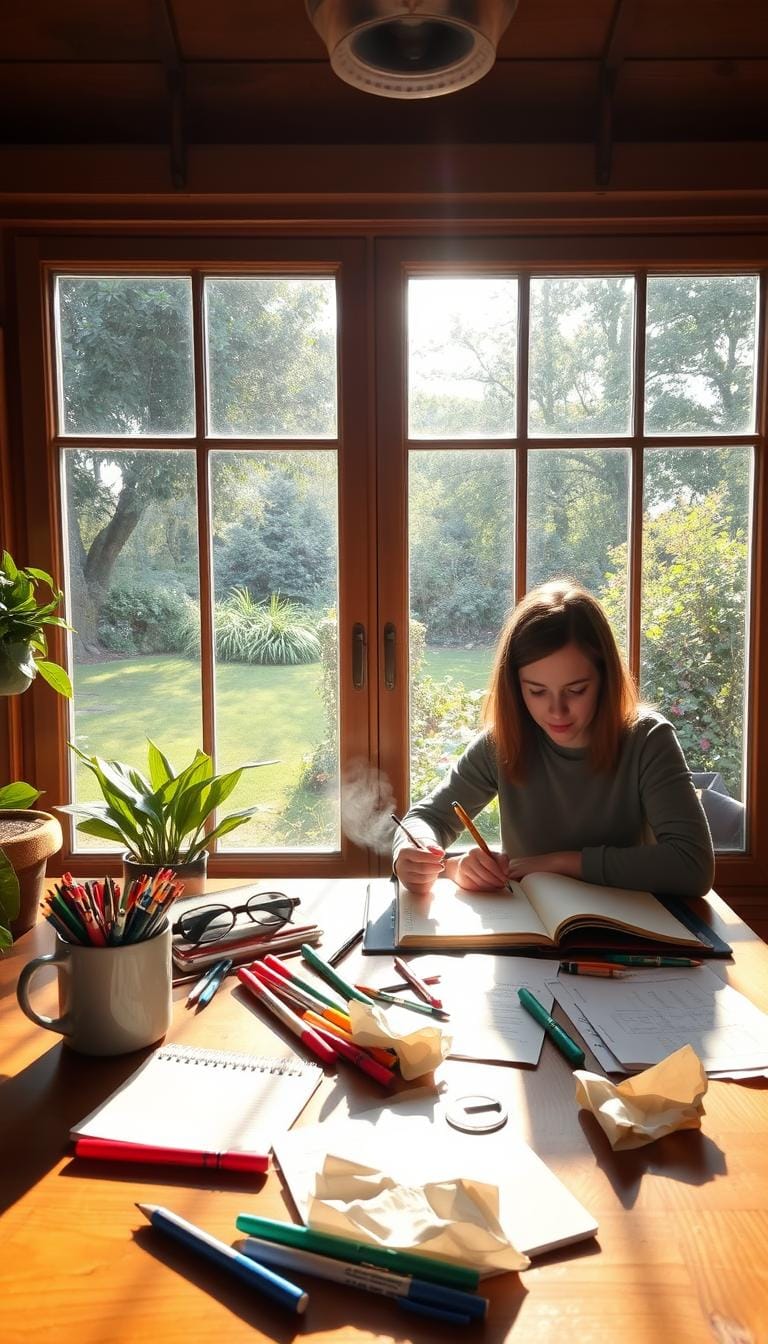Creative Writing Activities: How to Overcome Writer’s Block in 3 Steps
Table of Contents
Ever stared at a blank page, unable to write? You’re not alone. Writer’s block is a common problem many writers face, and it’s really frustrating.
I know how hard it is, and I’m here to help. In this article, we’ll look at how creative writing activities can help you beat this block. We’ll cover three easy steps to get your writing going again.

By the end of this article, you’ll know how to use writing prompts and other methods to overcome writer’s block. Let’s start this journey to unlock your writing ability.
The Reality of Writer’s Block: Why It Happens and Who It Affects
Many people struggle to write when they need to. Writer’s block is a big problem for writers in all fields and at all levels.
The Psychology Behind Creative Barriers
Writer’s block often comes from inside our minds. Creative barriers can be caused by self-doubt, fear of failure, and the need to be original. Knowing why it happens is key to solving it.
The blank page can be scary, standing for the big challenge ahead. This fear can stop us from writing.
Common Triggers for Creative Blockages
Many things can cause writer’s block, like tight deadlines, no inspiration, and personal problems. Things outside us, like distractions or others’ opinions, can also get in the way.

By knowing what causes it, writers can start to break through their creative barriers. This helps them get back to writing well.
Signs You’re Experiencing Writer’s Block (Not Just Procrastination)
It’s important to know the difference between writer’s block and procrastination. Procrastination is about delaying tasks because you lack motivation or fear failure. Writer’s block, on the other hand, makes it hard to come up with ideas or make progress on your writing.
Mental and Emotional Indicators
Writer’s block can show itself in certain ways. You might feel:
- Self-doubt and criticism: Being too hard on yourself or doubting your writing skills.
- Anxiety or fear: Feeling stressed about writing or worried that your work won’t be good enough.
- Lack of inspiration: Finding it hard to think of new ideas or feeling uninspired by your project.
Impact on Your Writing Quality and Quantity

- Writing less than usual.
- Having trouble meeting deadlines or finishing writing tasks.
- Feeling like your writing isn’t as good because of the stress and frustration.
Spotting these signs is the first step to beating writer’s block and getting back to writing well.
Why Traditional “Just Push Through It” Advice Often Fails
When you hit writer’s block, the usual advice to keep going can actually make things worse. It can lead to frustration and lower productivity for many writers. They feel stuck and can’t move forward.
The Counterproductive Nature of Forcing Creativity
Trying to force creativity often ends in failure. Writers might produce poor work or feel exhausted. The real solution is to understand why you’re blocked, not just push through.
When Taking a Break Actually Makes Things Worse
Even taking a break can sometimes make things worse. It can make it harder to get back into your writing. Finding the right balance is key to keeping your momentum going.
| Approach | Short-term Effect | Long-term Effect |
|---|---|---|
| Forcing Creativity | Initial frustration | Burnout and decreased quality |
| Taking a Break | Temporary relief | Loss of momentum |
| Balanced Approach | Gradual progress | Sustained creativity and quality |
Understanding the flaws in old advice can help writers overcome writer’s block. They can then build a more lasting creative practice.
Step 1: Reconnect with Your Creative Source
The journey to beat writer’s block starts with finding your creative spark again. We’ve all been there – facing a blank page with no ideas. But our creative spark is always there, waiting to be lit up again.
To find this spark, we must quiet our minds and listen to our subconscious. Mindfulness techniques help us do this. They teach us to watch our thoughts without judging, unlocking our creative power.
Mindfulness Techniques for Writers
Mindfulness is more than meditation; it’s about being aware in everyday life. For writers, it means noticing the feel of writing, the sound of typing, or the sensation of the pen. Simple acts like focusing on breathing or noticing our surroundings can calm our minds and spark creativity.
Journaling Activities to Unlock Subconscious Ideas
Journaling is a key tool for tapping into our subconscious. Writing down our thoughts and feelings can reveal hidden patterns and insights that shape our writing.
Stream of Consciousness Writing Exercises
Stream of consciousness writing is a powerful journaling technique. It involves writing whatever comes to mind without stopping. It helps us relax and enter a flow state where ideas flow freely.
Guided Reflection Prompts That Work
Guided reflection prompts can also spark creativity. Simple prompts like “What if…” or “Describe a childhood memory” can guide us into deep reflection and imagination.
By adding mindfulness and journaling to our daily routine, we reconnect with our creative source. This not only helps us overcome writer’s block but also makes our writing richer and more vivid.
Remember, the goal is to let creativity flow naturally. With patience and practice, we can unlock our inner well of ideas and let our writing grow.
Creative Writing Activities That Reignite Your Imagination
Overcoming writer’s block starts with sparking your imagination through creative writing activities. These activities challenge your view and boost your creativity. They help you break through mental barriers that stop you from writing.
Unconventional Writing Prompts That Challenge Perspective
Unconventional writing prompts are great for sparking your imagination. They push you out of your comfort zone and make you think differently. For instance, you might write from an object’s point of view or create a story in a fantastical world.
- Write a story in a world with different physical laws.
- Create a character who finds a hidden world in their reflection.
- Describe a memory from someone who wasn’t there.
Storytelling Games to Play Solo or with Fellow Writers
Storytelling games are another great way to spark your imagination. You can play them alone or with others. They help generate new ideas and perspectives. A popular game is writing a story in a series of prompts or with certain constraints.
- Start a story and then pass it to a fellow writer to continue.
- Write a story in just 50 words.
- Create a character and write from their perspective.
Character Development Tasks That Bypass Mental Blocks
Character development tasks help you overcome mental blocks by focusing on your characters. By exploring their motivations, desires, and fears, you create more believable characters. This can spark your imagination and get you writing again.
Try these tasks:
- Write a character’s backstory to understand their motivations.
- Write a dialogue between two characters with different views.
- Describe a character’s emotional state through their surroundings.
Step 2: Restructure Your Creative Environment and Process
Changing your creative space is key to sparking your imagination. Your surroundings greatly affect your creativity and work output. Simple changes can turn your space into a source of inspiration, helping you beat writer’s block.
Designing Your Physical Space for Optimal Creativity
Your workspace can either boost or block your creativity. To make it better, think about these tips:
- Clear your space to avoid distractions.
- Choose furniture that’s comfy for long writing sessions.
- Add things that spark your creativity, like art or plants.
Digital Tools and Apps That Support Creative Flow
Today, many digital tools and apps help writers stay creative. Here are some examples:
Organization Systems for Writers
Scrivener and Trello are great for organizing your work. They keep all your projects, notes, and research in one spot, making complex writing easier.
Distraction Management Techniques
Freedom and StayFocusd block distracting websites and apps. This lets you focus on your writing without interruptions.
| Tool/App | Purpose | Benefit |
|---|---|---|
| Scrivener | Project Management | Organizes manuscripts, notes, and research. |
| Trello | Task Management | Visualizes tasks and deadlines. |
| Freedom | Distraction Blocking | Blocks distracting websites and apps. |
| StayFocusd | Productivity Enhancement | Enhances focus by limiting non-essential browsing. |
By changing your creative space and using the right digital tools, you can boost your writing. This will make your work more productive and creative.
Breaking Down the Writing Process into Micro-Challenges
Starting a new writing project can feel daunting. Breaking it down into smaller tasks can change everything. This way, writers can tackle a big project one step at a time.
Using plot generator tools is a great strategy. These tools spark new ideas and directions in your story. They’re perfect when you hit a creative wall.
Plot Generator Methods That Spark New Directions
There are many types of plot generators. Some are simple, like random word generators. Others use complex algorithms to suggest plot twists. A plot generator can open up new paths in your story.
For example, if you’re stuck on the climax, a plot generator can suggest unexpected twists. This adds depth and complexity to your story.
Setting and World-Building Exercises
Another challenge is to focus on world-building exercises. Creating the setting of your story can be incredibly inspiring. It involves making detailed descriptions of environments, cultures, and histories.
Engaging in world-building exercises helps you dive deep into your story’s world. It sparks ideas for characters and plot developments.
Dialogue Development Through Imaginative Scenarios
Working on dialogue development is also a great challenge. You can imagine scenarios where characters interact in new ways. This reveals their personalities, backgrounds, and motivations.
For instance, imagine a conversation between two characters in a new environment. It can expose new sides of their relationship and open up new plot paths.
| Micro-Challenge | Description | Benefit |
|---|---|---|
| Plot Generators | Tools that suggest new plot directions or twists | Sparks creativity and new ideas |
| World-Building Exercises | Activities that develop the story’s setting and environment | Enhances immersion and stimulates ideas |
| Dialogue Development | Exercises that focus on character interactions and conversations | Reveals character traits and creates plot opportunities |
By adding these micro-challenges to your writing routine, you can make steady progress. Even when faced with initial resistance or blockages, you can keep moving forward.
Step 3: Implement Consistent Practice Through Varied Approaches
The third step to beat writer’s block is to keep writing regularly with different methods. Being consistent is key to building a writing habit. This habit boosts creativity and productivity.
Try mixing up your writing activities every day, week, and month. This variety keeps your writing exciting and fresh.
Daily Free Writing Prompts That Build Momentum
Begin your day with free writing prompts. They make your writing flow better. For example, write about your dreams or a childhood memory. Or just write whatever pops into your mind without pause.
- Write for 10 minutes without stopping.
- Use a prompt like “Today I saw…” and expand on it.
- Describe a place that holds significance to you.
Weekly Poetry Workshops for Yourself
Weekly poetry workshops can spark your creativity. Poetry lets you play with language in a unique way. You can find prompts online or make your own based on themes or feelings.
Try writing a poem about a personal experience or feeling. Use metaphors or similes to describe it. This can unlock your creative subconscious and bring new ideas to your writing.
Monthly Genre-Switching Challenges
Join monthly genre-switching challenges to write in a style you’re not used to. For example, if you write fiction, try non-fiction or a script. This keeps your writing fresh and exciting.
Some ideas for switching genres include:
- Writing a short story in a genre you’re not familiar with.
- Turning a piece of your writing into a different format, like a screenplay.
- Trying different narrative voices or styles.
By using these varied methods, you’ll not only beat writer’s block but also improve your writing skills.
Measuring Your Progress: Tracking Your Journey from Blocked to Flowing
Measuring progress is key to staying motivated in writing. By tracking my output and celebrating small victories, I see how far I’ve come. I also find areas to improve.
To monitor my creative output, I use a few systems. I keep a writing log to record my daily word count and topics. This log shows me what works best for me.
Practical Systems for Monitoring Creative Output
I also use a spreadsheet to track my progress. Plotting my word count against days helps me see my progress. Setting realistic goals for each session keeps me focused.
| Tool | Purpose | Benefit |
|---|---|---|
| Writing Log | Record daily word count and topics | Identify productivity patterns |
| Spreadsheet | Track progress over time | Visualize progress and stay motivated |
| Session Goals | Set realistic targets for each session | Stay focused and achieve consistent output |
Celebrating Small Wins and Learning from Setbacks
Celebrating small wins keeps me going. I reward myself for reaching milestones, no matter how small. This boosts my morale and reinforces good writing habits.
Learning from setbacks is also key. When I hit a block or miss targets, I reflect on why. This helps me adjust and find new strategies for future challenges.
By tracking progress, celebrating wins, and learning from setbacks, I keep my writing routine healthy and productive.
Conclusion: Transforming Writer’s Block into Creative Opportunity
Writer’s block is not a barrier that can’t be overcome. It’s a chance to grow and get creative. By understanding why we get stuck and recognizing the signs, we can turn it into something positive.
Using mindfulness, journaling, and unique prompts can spark our imagination. Changing our writing space and sticking to a routine can help us break free. This way, we can overcome the mental hurdles that stop us.
Every writer’s path is different. By tracking our progress and celebrating small victories, we stay motivated. Remember, facing challenges is normal, but how we tackle them matters. By using the strategies from this article, we can unlock our creativity and use writer’s block to our advantage.






